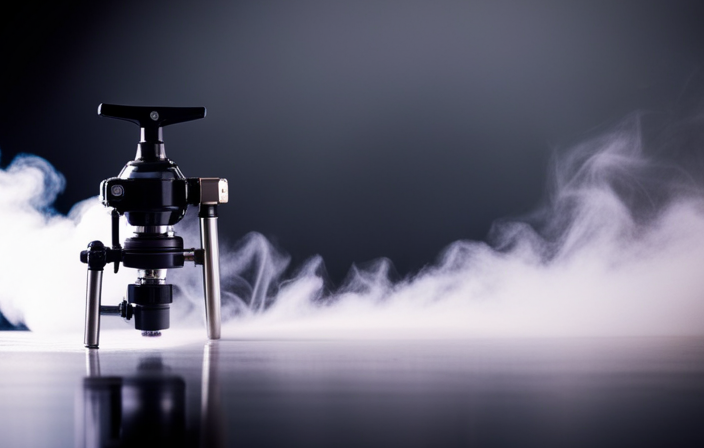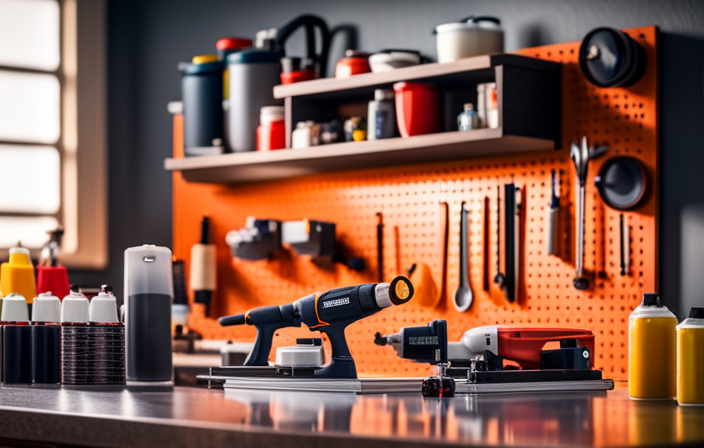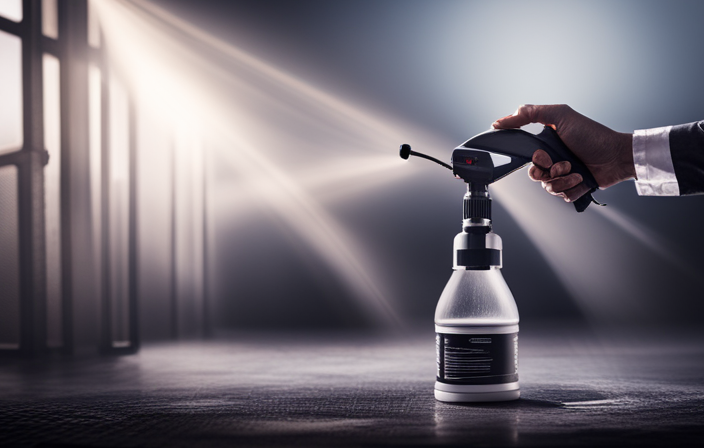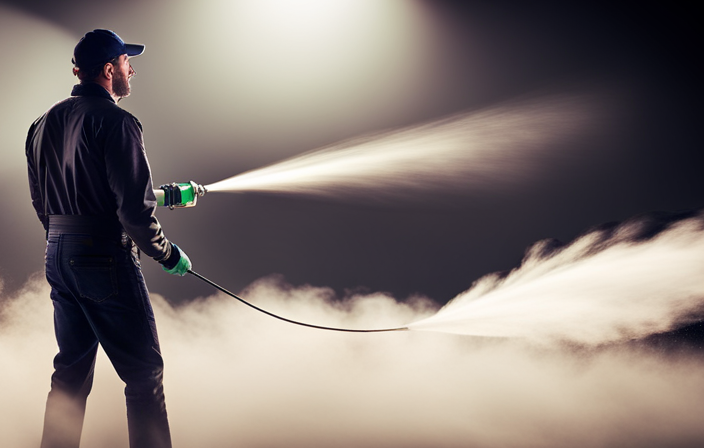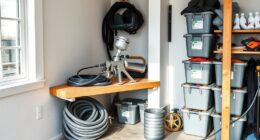As an experienced painter, I have encountered many unexpected challenges in my work. One common issue is when paint gets stuck in an airless sprayer. It’s a simple mistake to make – getting so focused on your painting that you forget to clear the sprayer, leading to a troublesome situation. But don’t fret, I am here to demonstrate how you can fix this problem.
Properly cleaning the sprayer after use is crucial to prevent any clogs or damage. Disposing of excess paint responsibly is also important for the environment. Storing leftover paint in airtight containers will keep it fresh and usable for future projects. Using a paint strainer can help remove any debris that may have accumulated in the sprayer. It’s crucial to avoid mixing different types of paints, as this can lead to unwanted reactions. Following the manufacturer’s instructions for maintenance is essential for keeping your sprayer in tip-top shape.
So, whether you’re a seasoned pro or a DIY enthusiast, this article will provide you with the knowledge and guidance needed to handle leftover paint in your airless sprayer like a pro.
Let’s dive in and get those sprayers back in action!
Key Takeaways
- Remove and clean the airless sprayer according to manufacturer’s instructions for poor spray performance.
- Seek professional help for safe handling and disposal of leftover paint.
- Follow maintenance tips and ensure the sprayer is in proper working condition.
- Dispose of remaining paint properly to protect yourself and the environment.
Properly Clean the Sprayer After Use
After you’ve finished using the airless sprayer, make sure to properly clean it so that any leftover paint is completely removed and the sprayer is ready for future use. Properly maintaining the sprayer equipment is crucial to avoid clogging issues and ensure its longevity.
Start by disconnecting the sprayer from the power source and relieving any pressure by triggering the gun into a waste container. Next, remove the spray tip, filter, and guard, and clean them thoroughly with warm soapy water. Use a brush to remove any dried paint from the sprayer’s components.
Flush the sprayer with clean water until the water runs clear, and then reassemble the sprayer. By following these steps, you can prevent paint buildup and keep your sprayer in optimal condition.
Now, let’s move on to how to dispose of excess paint responsibly.
Dispose of Excess Paint Responsibly
Make sure you dispose of any extra paint responsibly. Proper disposal of paint is crucial to minimize its environmental impact. Here are five important points to keep in mind:
-
Check local regulations: Before disposing of excess paint, research your local regulations on proper disposal methods. Some areas have specific guidelines that need to be followed.
-
Donate or share: If the paint is still usable, consider donating it to a local community center or sharing it with friends or neighbors who might need it.
-
Solidify the paint: If you have a small amount of leftover paint, you can solidify it by mixing in a paint hardener or kitty litter. Once solidified, it can be disposed of in the regular trash.
-
Recycling centers: Look for nearby recycling centers that accept paint. They can properly handle and recycle the paint, reducing its impact on the environment.
-
Hazardous waste facilities: If your paint is considered hazardous, such as oil-based paints, bring it to a hazardous waste facility for proper disposal.
By disposing of excess paint responsibly, we can minimize its impact on the environment.
Next, I will discuss the importance of storing leftover paint in airtight containers.
Store Leftover Paint in airtight Containers
To ensure the longevity of your leftover paint, keep it stored in airtight containers like a sealed vault, preserving its quality and preventing unnecessary waste. Proper storage is crucial in maintaining the paint’s usability for future projects. By sealing the paint in airtight containers, you create a barrier that prevents air and moisture from altering its composition. This simple step not only extends the paint’s lifespan but also saves you money by avoiding the need to purchase new paint for your next project. To emphasize the importance of proper storage, consider the following table:
| Benefits of Proper Storage | |
|---|---|
| Preserves paint quality | |
| Prevents drying out or thickening | |
| Reduces the risk of bacteria or mold growth | |
| Minimizes exposure to air and moisture | |
| Saves money by avoiding paint wastage |
By implementing these storage practices, you can prevent paint waste and ensure that your leftover paint remains in excellent condition. Once stored correctly, the next step is to use a paint strainer to remove any debris and prepare the paint for future use.
Use a Paint Strainer to Remove any Debris
Ensure the quality of your leftover paint by using a paint strainer to effortlessly eliminate any debris and prepare it for future projects. A paint strainer is a simple yet effective tool that helps achieve a smooth and flawless finish. Here are three benefits of using a paint strainer:
-
Improved painting results: By removing any debris or impurities, a paint strainer ensures that your paint goes on smoothly and evenly, resulting in a professional-looking finish.
-
Extended paint lifespan: Common debris found in paint, such as dried paint flakes or dust particles, can affect the paint’s texture and consistency. Using a strainer prevents these contaminants from clogging your spray gun or brush, thus prolonging the lifespan of your paint.
-
Time and money savings: Filtering the paint through a strainer prevents blockages, which can lead to costly equipment repairs or replacements. It also saves time by reducing the need for rework due to uneven application.
By using a paint strainer, you can avoid mixing different types of paints, ensuring optimal results for your future projects.
Avoid Mixing Different Types of Paints
Mixing different types of paints can be a recipe for disaster, resulting in a chaotic and unpredictable outcome for your project. To avoid this, it is crucial to understand the importance of not shaking the sprayer vigorously when changing paint types. This can prevent the paints from mixing inside the sprayer, which could lead to clogs or uneven application. Additionally, consider using a paint conditioner to help improve the compatibility of different paint types. This can help ensure a smoother and more consistent spray pattern. Another key factor to consider is the drying time of each paint used. Different paints have different drying times, so it is important to allow sufficient drying time between coats to prevent smudging or running. By following these guidelines, you can avoid potential issues and achieve professional-looking results. Now, let’s move on to the next section about keeping the sprayer nozzle clean and clear.
Keep the Sprayer Nozzle Clean and Clear
When it comes to using an airless sprayer, it’s crucial to keep the nozzle clean and clear for optimal performance. Failure to do so can lead to clogging and uneven paint application. To ensure the nozzle remains in top shape, there are a few cleaning techniques and troubleshooting tips to keep in mind:
- Regularly flush out the sprayer with the appropriate solvent or cleaning solution.
- Use a small brush or toothpick to remove any dried paint or debris from the nozzle.
- Check and clean the filter regularly to prevent buildup.
- Consider using a nozzle shield or guard to protect the nozzle from clogs caused by overspray.
By following these steps, you can maintain a clean and clear sprayer nozzle, ensuring smooth and consistent paint application.
Now, let’s move on to the next section, where we’ll discuss the importance of following the manufacturer’s instructions for maintenance.
Follow Manufacturer’s Instructions for Maintenance
It’s important to follow the manufacturer’s instructions for maintenance to keep your sprayer running smoothly and avoid any potential issues. Proper maintenance is key to ensuring the longevity and efficiency of your airless sprayer. Here are some troubleshooting tips and guidelines to help you maintain your sprayer effectively:
| Maintenance Tip | Description |
|---|---|
| Clean the filters regularly | Clogged filters can result in poor spray performance. Remove and clean them according to the manufacturer’s instructions. |
| Check the pump packings | Inspect the pump packings for any signs of wear or leakage. Replace them if necessary to prevent paint from leaking into the motor. |
| Lubricate the sprayer | Apply lubricant to the necessary parts as specified by the manufacturer. This will help reduce friction and keep the sprayer running smoothly. |
By following these maintenance tips, you can ensure that your airless sprayer stays in optimal condition. In the next section, we will discuss how to use paint thinner or solvent to clean the sprayer without damaging its components.
Use Paint Thinner or Solvent to Clean the Sprayer
After following the manufacturer’s instructions for maintenance, it’s time to move on to the next step in dealing with leftover paint in an airless sprayer. In situations where paint thinner or solvent isn’t readily available, there are alternative cleaning methods that can be used.
One option is to use warm soapy water, which can help loosen and remove the paint residue. Another alternative is to use vinegar, which can be mixed with water to create a solution that breaks down the paint. Additionally, rubbing alcohol can be effective in dissolving paint and cleaning the sprayer.
It’s important to thoroughly rinse and clean the sprayer after using any of these alternatives. This will ensure that no residue is left behind, preventing potential clogs or issues during the next use.
Now that we’ve discussed alternative cleaning methods, let’s move on to the next step: testing the sprayer with water or a non-toxic solvent before the next use.
Test the Sprayer with Water or a Non-Toxic Solvent before Next Use
Before moving on to the next step, it’s crucial to ensure the sprayer is in proper working condition by testing it with water or a non-toxic solvent.
This step is important to ensure the effectiveness of the sprayer and to avoid any potential issues or malfunctions during the next use. Start by filling the sprayer with water or a non-toxic solvent, following the manufacturer’s instructions. Then, turn on the sprayer and test it by spraying onto a test surface.
Check if the spray pattern is consistent and if the sprayer is functioning properly. Additionally, make sure to follow all safety precautions, such as wearing protective gear and operating the sprayer in a well-ventilated area.
By testing the sprayer, you can ensure a smooth and successful painting experience. Now, if you’re unsure about handling leftover paint or any other aspect of the sprayer, it’s always best to seek professional help.
Seek Professional Help if you’re unsure about handling leftover paint
If you’re uncertain about how to handle any remaining paint, seeking professional assistance can help alleviate any concerns and ensure a smooth painting process. Seeking professional advice is crucial when dealing with leftover paint in an airless sprayer. Professionals have the experience and knowledge to guide you on the proper disposal methods, ensuring that you’re following regulations and protecting the environment. They can provide valuable information on how to safely remove and store the paint, preventing any potential accidents or damage.
Proper disposal methods are essential to protect both yourself and the environment from any harmful effects of the leftover paint. So, don’t hesitate to reach out to professionals who can provide guidance and ensure the safe handling and disposal of any remaining paint in your airless sprayer.
Frequently Asked Questions
Can I leave leftover paint in the airless sprayer overnight?
Yes, leftover paint can cause clogs in airless sprayers. It is not safe to leave paint in the sprayer overnight as it can dry and harden, making it difficult to clean and potentially damaging the equipment.
What can happen if I don’t properly clean the sprayer after use?
Neglecting sprayer maintenance can have serious consequences. The impact of improper sprayer cleaning includes clogged or damaged parts, reduced performance, and decreased lifespan. Regularly cleaning the sprayer is crucial for optimal functioning and longevity.
How long can I store leftover paint in airtight containers?
Leftover paint can be stored in airtight containers for an extended period, typically up to 2 years. However, the shelf life depends on factors such as the type of paint and proper storage conditions.
Can I reuse leftover paint that has been strained and stored properly?
Reusing leftover paint is possible when stored properly. Ensure it has been strained to remove any impurities. Proper storage techniques, such as sealing the container tightly and storing in a cool, dry place, will help maintain its quality.
What should I do if I accidentally mix different types of paints in the sprayer?
If I accidentally mix different types of paints in the sprayer, I need to be careful of potential paint reactions and avoid paint clogs. It’s important to thoroughly clean the sprayer before switching to a different type of paint to prevent any issues.
Conclusion
In conclusion, properly handling leftover paint in an airless sprayer is crucial to ensure its longevity and effectiveness. By following the steps outlined in this article, you can maintain the sprayer’s performance and prevent any issues down the line.
Remember, just like a well-maintained car engine runs smoothly, a clean and well-cared-for sprayer will provide you with flawless paint application. So take the time to clean, store, and maintain your sprayer, and it’ll reward you with beautiful, professional results every time.



